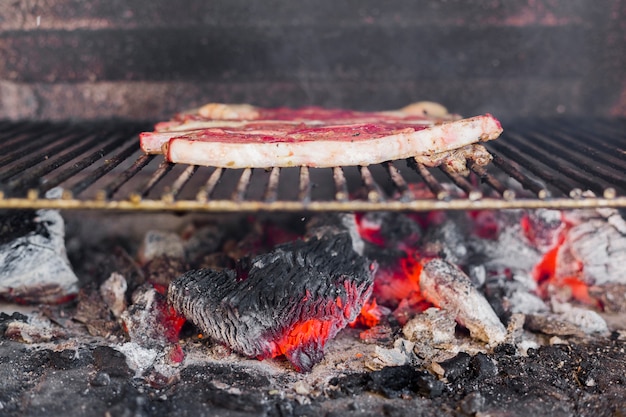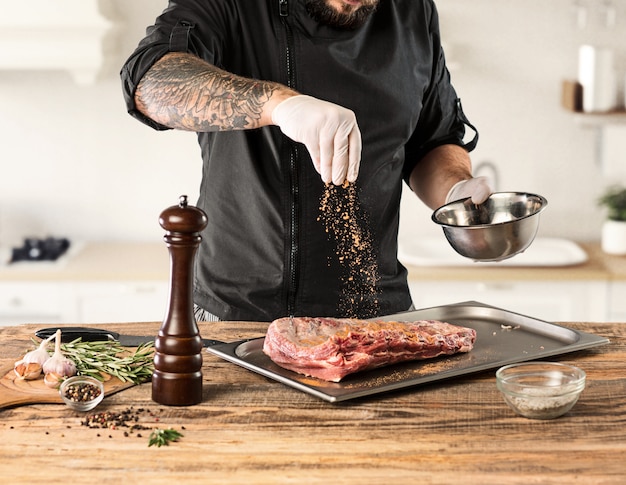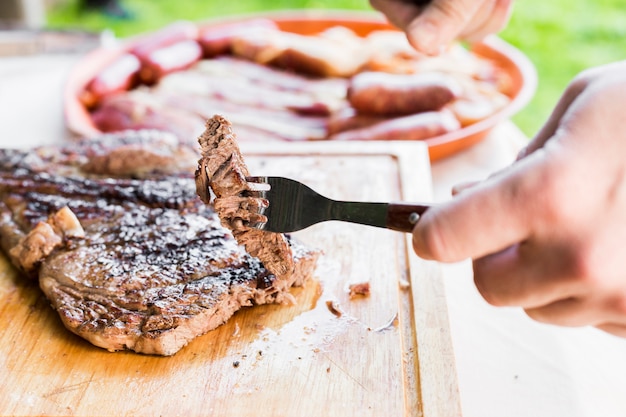You've seen the drool-worthy pictures, the tantalizing smells wafting from BBQ joints, and the Instagram posts of perfectly smoked brisket. Now, you're ready to take on the challenge yourself! But let me tell you, smoking a brisket is not just about chucking some meat on the smoker and calling it a day. It's a journey, a slow dance between fire and patience, with a bit of know-how thrown in for good measure.
I've spent years experimenting with different methods and techniques, learning from both successes and (let's be honest) a few epic brisket fails. I'm here to share all that I've learned, guiding you through this delicious journey from choosing the perfect brisket to mastering the smoking process. And don't worry, I'll sprinkle in some personal anecdotes and tips along the way.
So, grab a cuppa, put on your apron, and let's dive into this brisket masterclass!
(Part 1) Choosing Your Brisket: The Foundation of Success

Just like a good foundation is essential for a sturdy house, choosing the right brisket is vital for a perfect smoke. You wouldn't build a castle on sand, would you? So, ditch the idea of grabbing the first brisket you see at the butcher's. You need to be a bit more discerning.
The Cut: Flat vs. Point: A Tale of Two Muscles
First off, let's talk about the brisket itself. It's not just one big chunk of beef, you know. A brisket is actually made up of two distinct muscles: the flat and the point.
The flat, the leaner and longer muscle, gives you a more uniform, even slice of meat. It's perfect for thin slices, ideal for sandwiches or enjoying it on its own.
Then there's the point, thicker and fattier, offering a more succulent and flavorful experience. This is the star of the show for pulled brisket, the part that melts in your mouth with every bite.
Now, you've got two options:
- Whole Brisket: You get the best of both worlds, with the flat and the point together. But it does mean more time and effort to cook, especially for beginners.
- Half Brisket: You can choose either the flat or the point, depending on your preference and what you plan to do with it. This is a great option if you're just starting out or if you have a smaller smoker.
The Weight: Size Matters (But Not Too Much)
When it comes to brisket weight, bigger isn't always better. A 10-12 pound brisket is a great starting point. Anything larger can be intimidating, especially if you're new to the game. You'll need a smoker big enough to accommodate it and enough time to cook it properly.
The Marbling: The More, the Merrier
Don't be afraid of a bit of fat! In fact, embrace it! Look for a brisket with good marbling, meaning there are streaks of fat running through the meat. This fat will melt during cooking, adding flavour and tenderness, making your brisket more juicy and delicious. The more marbling, the better!
The Color: A Sign of Freshness
A fresh brisket should have a bright, red colour. Avoid any that are dull or have a purplish hue. These are signs that the meat might not be as fresh and could result in a less than ideal outcome.
The Feel: A Touch Test
Give the brisket a gentle press. It should feel firm and springy, not mushy or soft. This indicates it's fresh and well-handled.
(Part 2) Preparing the Brisket: Getting Ready for the Smoker

You've chosen your perfect brisket. Now, it's time to prepare it for its starring role in the smoker. This stage is about setting the brisket up for success, ensuring it's perfectly seasoned and prepped for those long hours in the smoke.
Trimming the Fat: Less is More
Brisket comes with a generous amount of fat, which is a good thing, but not too much of it! We need to trim the fat, but not overdo it.
You want to remove the majority of the thick layer of fat on the top, leaving a thin layer for moisture and flavour. I usually aim for about ?? inch of fat. You can trim around the edges too, but keep in mind that the fat will melt and baste the meat during cooking, adding flavour.
Seasoning the Brisket: The Magic Touch
Now, the fun part! This is where you get to make your brisket your own. The key here is not to overcomplicate things. A simple salt and pepper rub goes a long way, trust me. But if you're feeling adventurous, feel free to experiment with your favourite seasonings.
Here's my go-to rub:
- Kosher salt (it has a larger grain size and doesn't absorb as much moisture as table salt)
- Freshly ground black pepper (always use freshly ground pepper for the best flavour)
- Garlic powder
- Onion powder
- Paprika
- Chili powder (optional for a bit of heat)
Mix these spices together and rub them all over the brisket, making sure to cover it evenly. Don't be shy, press that rub into the meat!
Injecting the Brisket: Optional But Oh-So-Good
Injecting the brisket is optional, but I reckon it's a great way to boost flavour and moisture. It's not rocket science, you just use a meat injector to inject a marinade or brine into the meat.
Here's what I like to use:
- Apple juice (adds sweetness and a hint of fruitiness)
- beef broth (adds depth of flavour and moisture)
- Worcestershire sauce (adds umami and a touch of tang)
- Garlic and onion powder (enhances the flavour profile)
Mix these together and inject the brisket all over, making sure to reach all the nooks and crannies. This ensures the meat is evenly seasoned and adds a juicy boost.
Wrapping the Brisket: A Warm Embrace
After the initial smoke, you'll want to wrap the brisket in butcher paper. This helps steam the brisket, allowing it to cook evenly and break down the connective tissue, creating that melt-in-your-mouth texture.
Just lay out a large piece of butcher paper, place the brisket in the centre, and fold the paper over, sealing the edges to create a tight package.
(Part 3) The Smoking Process: A Dance with Fire and Patience

You've prepped your brisket, the smoker is hot and ready, now it's time for the grand finale – the smoking process. This is where you'll truly appreciate the art of slow and low cooking.
Setting the Temperature: Finding the Sweet Spot
The key to smoking a brisket is to cook it low and slow. Aim for a temperature between 225°F and 250°F (107°C to 121°C). This allows the meat to cook evenly and break down the tough connective tissue, resulting in a tender and juicy brisket.
Adding Smoke: The Essence of Flavor
You've got your smoker fired up and ready to go, now you need to add the smoke. This is where you get to play with wood and experiment with different flavours.
Here are some popular wood choices:
- Hickory: Provides a strong, smoky flavour, perfect for traditional BBQ.
- Mesquite: Adds a bolder, almost spicy flavour.
- Oak: Offers a milder, more balanced smoke.
- Applewood: Creates a sweeter, fruity flavour.
- Cherrywood: Provides a delicate, slightly tart smoke.
You can use one type of wood or mix them together to create your own signature flavour profile. Just remember, less is more. Too much smoke can overwhelm the taste of the meat.
The Stall: A Moment of Patience
You'll notice a bit of a stall during the cooking process, where the brisket seems to stop cooking. This is normal and nothing to worry about. It’s a natural occurrence that happens as the meat reaches a certain temperature. The stall is just a bit of a waiting game. Don’t panic, just keep the smoker going and the brisket will eventually break through the stall and continue cooking.
The Wrap: The Finishing Touch
Once the brisket reaches an internal temperature of about 160°F (71°C), it’s time to wrap it in butcher paper. This helps steam the brisket, allowing it to cook more evenly and break down the connective tissue. Keep the brisket in the smoker until it reaches an internal temperature of 200°F (93°C).
The Rest: Letting It Relax
Once the brisket is cooked, don’t rush to slice it up. Let it rest for at least 2 hours, wrapped in the butcher paper, before slicing. This allows the juices to redistribute throughout the meat, resulting in a more tender and flavourful brisket.
(Part 4) The Signs of a Perfectly Cooked Brisket: Your Taste Buds Will Tell You
You've been tending to the smoker, checking the temperature, and waiting patiently. Now, it’s time to see if your hard work has paid off. Here are some signs you've got a perfectly cooked brisket:
The Texture: Tender and Juicy
A perfectly cooked brisket will be incredibly tender. It should melt in your mouth, with no resistance when you bite into it. The fat will have rendered down, creating a juicy and flavorful meat.
The Appearance: A Beautiful Bark
The brisket should have a nice, thick bark. This is the outer crust that forms from the smoke and seasoning. It should be dark and crispy, and have a slight sheen.
The Temperature: A Sign of Success
An internal temperature of 200°F (93°C) is a good indication that the brisket is cooked through. However, the best way to know is by using a meat thermometer. Insert it into the thickest part of the brisket to check the temperature.
The Pull Test: A Test of Tenderness
A good way to check if the brisket is tender is to do the pull test. Gently pull on a small piece of meat. If it pulls apart easily with minimal resistance, then you're good to go.
(Part 5) Slicing and Serving: Showcasing Your Culinary Triumph
The moment has arrived! Your brisket is cooked, rested, and ready to be sliced and served.
Slicing: Thin, Even, and Beautiful
To get the most out of your brisket, slice it thin and even. Use a sharp knife and slice across the grain of the meat. This helps to ensure each slice is tender and juicy.
Serving: The Star of the Show
There are endless ways to serve a brisket. It’s fantastic on its own, served with a simple side of potato salad or coleslaw. You can also use it to make sandwiches, tacos, or even nachos.
Here’s a basic serving idea:
- Slice the brisket thin and arrange it on a platter.
- Serve with a side of your favourite barbecue sauce.
- Add a few slices of onions and pickles for a tangy touch.
- Enjoy with a side of potato salad or coleslaw.
Don't forget to take a moment to appreciate your creation! It's a beautiful thing, and you've earned it.
(Part 6) Tips and Tricks: Lessons Learned the Hard Way
I've learned a few things along the way, some the easy way, others, well, not so much. Here are some tips and tricks that have helped me create delicious brisket:
- Don’t be afraid of a little fat: The fat will render down and baste the meat, adding flavour and moisture. Remember, fat equals flavour!
- Wrap the brisket tightly: This helps to create a steamy environment that helps cook the brisket evenly and create that tender texture.
- Use a meat thermometer: This is the best way to ensure the brisket is cooked through and safe to eat. Don't rely on guesswork, get yourself a reliable meat thermometer!
- Let the brisket rest: This allows the juices to redistribute throughout the meat, resulting in a more tender and flavourful brisket. Patience is key here!
- Experiment with different wood: This will allow you to create your own signature flavour profile. Have fun with it, you might find your new favourite wood!
- Don’t rush the process: Slow and low is the key to smoking a brisket. Be patient and let the meat cook slowly. Trust me, the wait is worth it.
(Part 7) Troubleshooting: When Things Don’t Go According to Plan
Let’s be honest, things don’t always go according to plan. Even the most seasoned brisket smoker has had their share of mishaps. Here’s how to deal with some common problems:
Dry Brisket: Too Much Smoke, Not Enough Moisture
If your brisket is dry, it’s likely you’ve overcooked it or not wrapped it tightly enough. Next time, try wrapping the brisket earlier or injecting it with some moisture before cooking.
Tough Brisket: Not Enough cooking time
If your brisket is tough, it’s likely you didn’t cook it long enough or at a low enough temperature. Next time, cook it longer at a lower temperature and make sure to wrap it in butcher paper.
Uneven Cooking: The Temperature Isn’t Consistent
If your brisket is unevenly cooked, it’s likely you didn’t maintain a consistent temperature in the smoker. Make sure your smoker is properly calibrated and adjust the temperature as needed.
Burnt Bark: Too Much Heat, Not Enough Attention
If your brisket has a burnt bark, it’s likely you’ve cooked it at too high of a temperature. Next time, keep the smoker at a lower temperature and keep a close eye on the brisket.
Overly Smoky Brisket: The Smoke’s Too Strong
If your brisket is overly smoky, it’s likely you used too much wood or cooked it for too long. Next time, use less wood or shorten the cooking time.
(Part 8) FAQs: Your Burning Questions Answered
I get it. You’ve got questions. That’s why I’m here to answer your burning questions about smoking brisket.
1. Can I use a charcoal grill instead of a smoker?
Absolutely! You can smoke brisket on a charcoal grill by creating a low and slow fire and using wood chips or chunks to add smoke. Just make sure you keep the temperature consistent throughout the cooking process. You might need to use a grill grate to keep the meat above the coals.
2. Can I cook a brisket in the oven instead of a smoker?
Yes, you can cook a brisket in the oven, but you won't get the same smoky flavour. If you’re looking for a quicker option, you can try cooking the brisket in the oven at a low temperature (250°F) with a little bit of wood chips or chunks. You can even buy smoking wood chips that are designed for use in the oven.
3. How long does it take to smoke a brisket?
The cooking time for a brisket will vary depending on the size and thickness of the meat, but it typically takes around 10-12 hours. It's a marathon, not a sprint, so be prepared to dedicate a whole day to your brisket masterpiece.
4. Can I freeze a brisket before smoking it?
Yes, you can freeze a brisket, but it's best to thaw it in the refrigerator for a few days before smoking. This allows the meat to thaw slowly and evenly, preserving the quality.
5. Can I use a rub and injection together?
Absolutely! In fact, using both a rub and injection can help create a more flavourful and juicy brisket. Just make sure you rub the brisket first, then inject it, and then wrap it in butcher paper. The rub adds a flavour barrier to the surface, while the injection infuses flavour throughout the meat.
(Part 9) The Rewards of Patience: The Essence of a Perfect Brisket
Smoking a brisket is a journey, not a race. It takes time, patience, and a little bit of love. But the rewards are well worth the effort. The moment you slice into that perfectly cooked brisket, with its tender texture, juicy flavour, and beautiful bark, you'll know all the hard work was worth it. You'll have a new appreciation for the art of slow and low cooking and a newfound confidence in your ability to create a culinary masterpiece. So, don't be afraid to take on the challenge. The journey is as rewarding as the destination.
Everyone is watching

Corn on the Cob: The Ultimate Guide to Perfectly Cooked Ears
Healthy MealsAh, corn on the cob. Just the name evokes images of sunny days, barbecues, and that sweet, juicy flavour that ...

Perfect Pork Roast Oven Cooking Time: A Guide to Delicious Results
Healthy MealsThere's something truly satisfying about a perfectly roasted pork. The aroma alone is enough to make your mout...

Ham Cooking Time: How Long to Bake, Smoke, or Boil a Delicious Ham
Healthy MealsAh, ham. It's a classic, isn't it? A real crowd-pleaser, especially around holidays. And when done right, it'...

Scallops: The Ultimate Guide to Perfect Cooking
Healthy MealsAh, scallops. Those delicate, sweet, and utterly delicious morsels of the sea. They hold a special place in my...

Spaghetti Squash: The Ultimate Guide to Cooking and Serving
Healthy MealsRemember that time you saw spaghetti squash at the supermarket, looking all bumpy and strange, and thought, "W...
